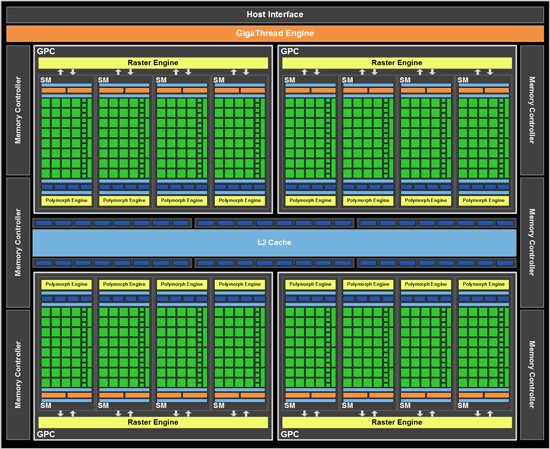NVIDIA's GeForce GTX 580: Fermi Refined
by Ryan Smith on November 9, 2010 9:00 AM ESTGF110: Fermi Learns Some New Tricks
We’ll start our in-depth look at the GTX 580 with a look at GF110, the new GPU at the heart of the card.
There have been rumors about GF110 for some time now, and while they ultimately weren’t very clear it was obvious NVIDIA would have to follow up GF100 with something else similar to it on 40nm to carry them through the rest of the processes’ lifecycle. So for some time now we’ve been speculating on what we might see with GF100’s follow-up part – an outright bigger chip was unlikely given GF100’s already large die size, but NVIDIA has a number of tricks they can use to optimize things.
Many of those tricks we’ve already seen in GF104, and had you asked us a month ago what we thought GF110 would be, we were expecting some kind of fusion of GF104 and GF100. Primarily our bet was on the 48 CUDA Core SM making its way over to a high-end part, bringing with it GF104’s higher theoretical performance and enhancements such as superscalar execution and additional special function and texture units for each SM. What we got wasn’t quite what we were imagining – GF110 is much more heavily rooted in GF100 than GF104, but that doesn’t mean NVIDIA hasn’t learned a trick or two.
Fundamentally GF110 is the same architecture as GF100, especially when it comes to compute. 512 CUDA Cores are divided up among 4 GPCs, and in turn each GPC contains 1 raster engine and 4 SMs. At the SM level each SM contains 32 CUDA cores, 16 load/store units, 4 special function units, 4 texture units, 2 warp schedulers with 1 dispatch unit each, 1 Polymorph unit (containing NVIDIA’s tessellator) and then the 48KB+16KB L1 cache, registers, and other glue that brought an SM together. At this level NVIDIA relies on TLP to keep a GF110 SM occupied with work. Attached to this are the ROPs and L2 cache, with 768KB of L2 cache serving as the guardian between the SMs and the 6 64bit memory controllers. Ultimately GF110’s compute performance per clock remains unchanged from GF100 – at least if we had a GF100 part with all of its SMs enabled.
On the graphics side however, NVIDIA has been hard at work. They did not port over GF104’s shader design, but they did port over GF104’s texture hardware. Previously with GF100, each unit could compute 1 texture address and fetch 4 32bit/INT8 texture samples per clock, 2 64bit/FP16 texture samples per clock, or 1 128bit/FP32 texture sample per clock. GF104’s texture units improved this to 4 samples/clock for 32bit and 64bit, and it’s these texture units that have been brought over for GF110. GF110 can now do 64bit/FP16 filtering at full speed versus half-speed on GF100, and this is the first of the two major steps NVIDIA took to increase GF110’s performance over GF100’s performance on a clock-for-clock basis.
| NVIDIA Texture Filtering Speed (Per Texture Unit) | |||||
| GF110 | GF104 | GF100 | |||
| 32bit (INT8) | 4 Texels/Clock | 4 Texels/Clock | 4 Texels/Clock | ||
| 64bit (FP16) | 4 Texels/Clock | 4 Texels/Clock | 2 Texels/Clock | ||
| 128bit (FP32) | 1 Texel/Clock | 1 Texel/Clock | 1 Texel/Clock | ||
Like most optimizations, the impact of this one is going to be felt more on newer games than older games. Games that make heavy use of 64bit/FP16 texturing stand to gain the most, while older games that rarely (if at all) used 64bit texturing will gain the least. Also note that while 64bit/FP16 texturing has been sped up, 64bit/FP16 rendering has not – the ROPs still need 2 cycles to digest 64bit/FP16 pixels, and 4 cycles to digest 128bit/FP32 pixels.
It’s also worth noting that this means that NVIDIA’s texture:compute ratio schism remains. Compared to GF100, GF104 doubled up on texture units while only increasing the shader count by 50%; the final result was that per SM 32 texels were processed to 96 instructions computed (seeing as how the shader clock is 2x the base clock), giving us 1:3 ratio. GF100 and GF110 on the other hand retain the 1:4 (16:64) ratio. Ultimately at equal clocks GF104 and GF110 widely differ in shading, but with 64 texture units total in both designs, both have equal texturing performance.
Moving on, GF110’s second trick is brand-new to GF110, and it goes hand-in-hand with NVIDIA’s focus on tessellation: improved Z-culling. As a quick refresher, Z-culling is a method of improving GPU performance by throwing out pixels that will never be seen early in the rendering process. By comparing the depth and transparency of a new pixel to existing pixels in the Z-buffer, it’s possible to determine whether that pixel will be seen or not; pixels that fall behind other opaque objects are discarded rather than rendered any further, saving on compute and memory resources. GPUs have had this feature for ages, and after a spurt of development early last decade under branded names such as HyperZ (AMD) and Lightspeed Memory Architecture (NVIDIA), Z-culling hasn’t been promoted in great detail since then.

Z-Culling In Action: Not Rendering What You Can't See
For GF110 this is changing somewhat as Z-culling is once again being brought back to the surface, although not with the zeal of past efforts. NVIDIA has improved the efficiency of the Z-cull units in their raster engine, allowing them to retire additional pixels that were not caught in the previous iteration of their Z-cull unit. Without getting too deep into details, internal rasterizing and Z-culling take place in groups of pixels called tiles; we don’t believe NVIDIA has reduced the size of their tiles (which Beyond3D estimates at 4x2); instead we believe NVIDIA has done something to better reject individual pixels within a tile. NVIDIA hasn’t come forth with too many details beyond the fact that their new Z-cull unit supports “finer resolution occluder tracking”, so this will have to remain a mystery for another day.
In any case, the importance of this improvement is that it’s particularly weighted towards small triangles, which are fairly rare in traditional rendering setups but can be extremely common with heavily tessellated images. Or in other words, improving their Z-cull unit primarily serves to improve their tessellation performance by allowing NVIDIA to better reject pixels on small triangles. This should offer some benefit even in games with fewer, larger triangles, but as framed by NVIDIA the benefit is likely less pronounced.
In the end these are probably the most aggressive changes NVIDIA could make in such a short period of time. Considering the GF110 project really only kicked off in earnest in February, NVIDIA only had around half a year to tinker with the design before it had to be taped out. As GPUs get larger and more complex, the amount of tweaking that can get done inside such a short window is going to continue to shrink – and this is a far cry from the days where we used to get major GPU refreshes inside of a year.











160 Comments
View All Comments
donjuancarlos - Tuesday, November 9, 2010 - link
Along that line it's shoo-in, not shoe-in. :)Ryan Smith - Tuesday, November 9, 2010 - link
In this house we obey the laws of thermodynamics!Thanks for the heads up, Don.
Troll Trolling - Tuesday, November 9, 2010 - link
You guys made my day.samspqr - Tuesday, November 9, 2010 - link
more important, where it says:"Both the Radeon HD 5970 and Radeon HD 6870 CF are worthy competitors to the GTX 580 – they’re faster and in the case of the 6870 CF largely comparable in terms of power/temperature/noise."
it should say:
"Both the Radeon HD 5970 and Radeon HD 6870 CF come out on top of the GTX 580 – they’re faster in nearly all benchmarks, and in both cases largely comparable in terms of price, power and temperature; 6870CF is also comparable in terms of noise, while 5970 comes out significantly louder."
DominionSeraph - Tuesday, November 9, 2010 - link
No, it should say, "Both 6850 CF and GTX460 SLI blow everything else out of the water given that they're practically giving away the highly overclockable 6850's for ~$185, 1GB GTX 460's for ~$180 AR, and 768MB GTX 460's for $145 AR."DreamerX5521 - Tuesday, November 9, 2010 - link
by looking at the test results, I guess 6870CF is a better choice than a single 580 in term of performance/watt, price (about the same), temperature, noise, etc..Kim Leo - Tuesday, November 9, 2010 - link
I noticed that as well, a little surprising I did expect a bit more considering all the hype, but then again it's built on the Fermi.I'm not sure what's up with the pricing? Do they think that there will be a market for GTX480 when Cayman comes and with the GF110 out?
Sihastru - Tuesday, November 9, 2010 - link
If you can live with the sub-par minimum framerates that plagues so many games with CF setups.JarredWalton - Tuesday, November 9, 2010 - link
Amen. I'm a 5850 CF user (and 4870X2 before that), and I can tell you I'd much rather have a single GPU and forget about profiles and other issues. But then, 30" LCDs need more than a single GPU in most games.B3an - Wednesday, November 10, 2010 - link
30" monitors dont need anything more than a high-end single GPU for most games. 99.9% of PC games are playable maxed out plus AA at 2560 res with just one of my 5870's in use, of with my previous 480. Theres only a handful of games that need dual GPU's to be playable at this res. Mainly because most games are console ports these days.And the OP is wrong, 6870 CF is not any better than the 580 with temperature or noise. 580 being better under load with noise, better with temps at idle, but only very slightly hotter under load.